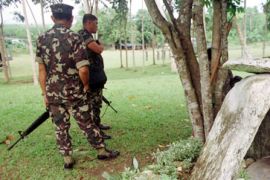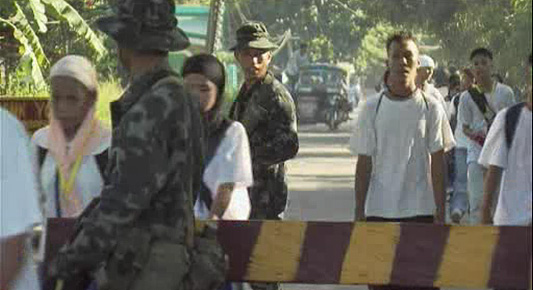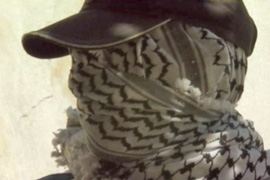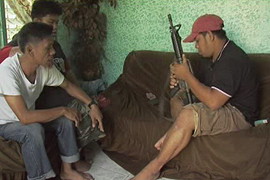Basilan’s cycle of violence
An island paradise becomes a breeding ground for angry, power-hungry young men.

 |
| Residents in Basilan have to negotiate checkpoints daily |
Reports from the national intelligence organisation in the Philippines say the Abu Sayyaf Group may have received fresh funding from foreign donors.
Al Jazeera visited the island of Basilan in the southern Philippines – once a stronghold of the group that is branded a terrorist organisation by the US – and found a community caught in a cycle of violence.
It was once among the poorest communities in the Philippines, but the first thing that strikes you when you approach the southern island of Basilan by boat is its neat, natural beauty.
Plantations spill over into another without any visible demarcation lines – and yet, life on the island of 300,000 people is all about boundaries and crossing them.
Checkpoints and armed camps dot the island and territories are “controlled” by various groups jostling for power and to get from one place to another, residents inevitably have to cross-over embattled areas.
The island community is built over underlying divisions, and is steeped in a culture of violence. In Basilan, guns fetch power and power gets respect.
| In video |
Kessar Abdil, a local resident shows Al Jazeera his .45 magnum and M-16, saying he would not be respected in the community without them.
The weapons allow him to protect his family and their property from the rampant lawlessness on the island.
But owning one of the hundreds of thousands of illegal weapons in Mindanao – many of them on Basilan – is not cheap.
Abu Sayyaf threat
For example the M-16, which locals refer to as “baby armalite”, costs around $1,500 – more than most residents make in a year.
Guns are a prime commodity – even used as dowry on occasion – and the proliferation of weapons has grown in part after the emergence of Abu Sayyaf on Basilan.
The Abu Sayyaf Group (ASG) was formed in the early 1990s by returning Filipino Muslim fighters who had studied in Saudi Arabia, and fought in Afghanistan alongside the Taliban.
They set themselves apart from the Moro National Liberation Front (MNLF), the main Muslim separatist group that had long operated in the Philippines, and was in peace talks with the government.
The ASG, though less in number, had a force numbering about 100 radical fighters who were younger, angrier, fiercer, more unscrupulous, and yet more fundamental in their beliefs.
Kidnappings, bombings and murder of civilians have all allegedly been committed during the past decade in the name of creating a separate Islamic state for the country’s Muslim minority.
The group, also known for beheading victims, was behind the largest ever attack on civilians in the Philippines that left more than 100 people dead when a ferry was bombed in February 2004.
 |
| “Abu Khalid” says he wants to leave Abu Sayyaf |
The ASG is considered a terrorist organisation by Manila and the US who link it to both al-Qaeda and the Indonesian-based Jemaah Islamiyah. The ASG has also provided training camps for foreign fighters from these groups..
The Philippines government had gone some way in decimating the group’s leadership and by 2003 its operations was seen as a model of progress and a success story in the US-led “war on terror”.
It was believed the ASG had all but left the island until the military launched an all-out offensive operation against the Abu Sayyaf on Basilan in August.
The group was back. But, locals say, it never really went away and two alleged members of the Abu Sayyaf met exclusively with Al Jazeera.
‘Sowing fear’
The men were in hiding, and refused to reveal their real identities. In a community where everyone is linked, they did not want to be recognised.
“I am not afraid of the soldiers or the cops, because they will just catch me… but if they [the ASG] find out I spoke to you – they will cut my head off,” Abu Khalid says.
Abu Khalid says he was with the ASG for over 4 years. He claimed to be a cousin of the group’s last remaining leader, Isnilon Hapilon, who has a $5 million reward.
Abu Khalid said he joined the group when he was in college, recruited by friends who told him becoming a “mujahedin” was a sure way to heaven.
But he says the group has changed and has been weakened by the government’s efforts leaving less than 30 “real” members, and that it has splintered into many sub-groups that are no longer under his cousin’s control.
Each group is out for itself, he said, recruiting its own members, conducting raids and sowing fear for their own benefits. Abu Khalid, with a family of his own now, wants out.
“I feel bad for those we victimised… so I ask forgiveness for what I’ve done,” he says. “I have a family now… it’s up to God if I die and go to hell… there’s nothing more I can do … I don’t want to go hungry anymore… I don’t want to be tired anymore…”
But at a time when Abu Khalid is growing tired, there are younger men like 25-year-old “Abu Kareem” who are stepping up to take his place.
Abu Kareem said he joined the ASG two years ago, not to fight for any greater political or religious cause, but to rebel against his parents.
Victims
Both Abu Khalid and Abu Kareem say new recruits were sent on “test missions” to prove their loyalty and readiness to join the group by conducting acts of random violence against the community.
Abu Khalid says they got more respect if the victims were Christians, or members of the military.
 |
| A gun is a prized possession in Basilan |
Nilo Baradino, the highly-respected island coroner, and 11 members of his family were among the ASG’s first kidnap victims in 1992 before they were released after a ransom was paid.
The 67-year-old, known as a local “avenger”, has kept meticulous files of the Abu Sayyaf, their activities, and their victims and says there is not one Basilan resident who has not been affected by the ASG.
A few years after the kidnapping, his son was killed by the same group. Since then, Barandino made it his mission to see the end of the ASG.
“At the moment, I still feel that it’s a responsibility of every citizen to fight lawlessness,” he says.
Because of his determination, 16 of his kidnappers were killed by the military.
But not all the victims are bold enough to bring their stories to the authorities. Many have decided to protect themselves.
Some young men have created their own private armies.
Residents believe these gang leaders take advantage of the island’s culture of violence, and foster the fear brought on by the mere existence of the ASG.
The on-going cycle of kill, or be killed, has turned an island paradise into an impoverished breeding ground for angry, power-hungry young men who only know how to perpetuate the cycle.
The Philippine government says it is struggling to break this cycle and for the moment the military has brought in its engineers in place of the soldiers.
But residents say they have seen all this before – an armed battle, then a fragile, temporary peace built on empty promises. It’s yet another cycle they want to break.
